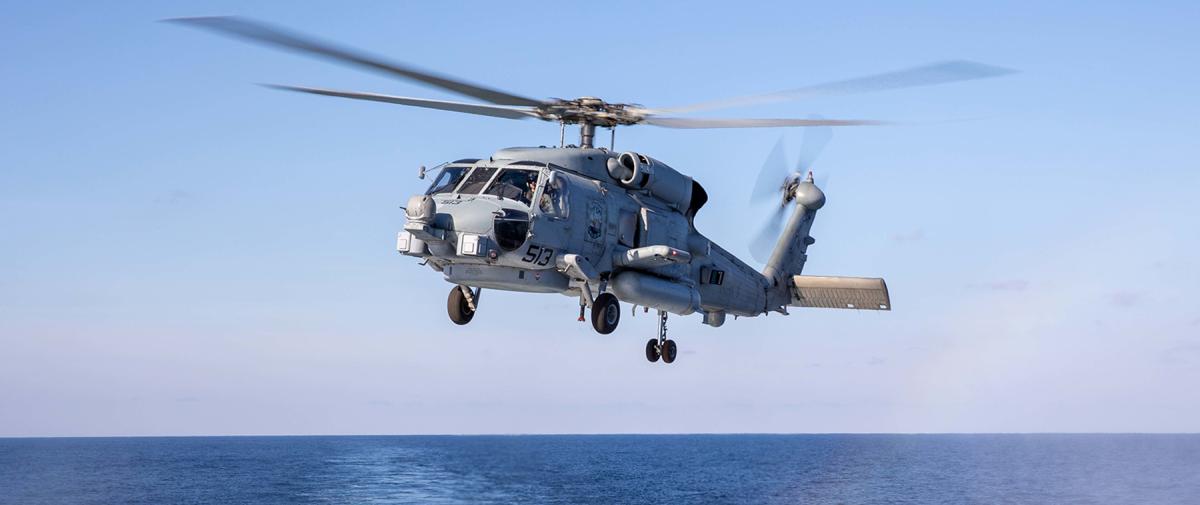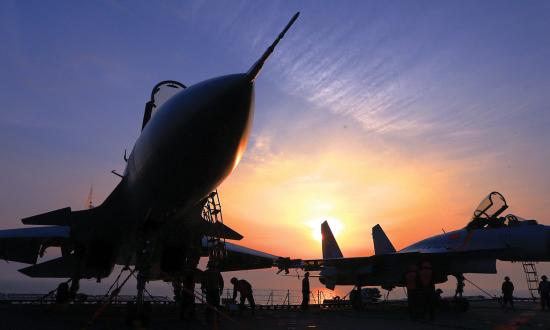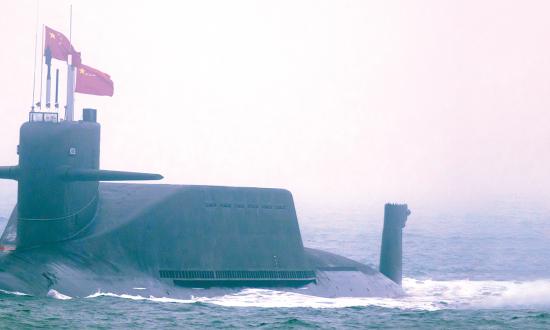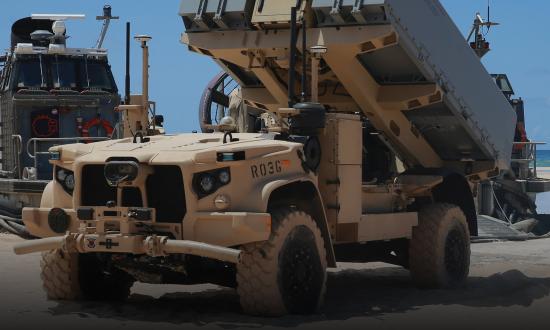Following the end of the Cold War, the U.S. Navy’s antisubmarine warfare (ASW) capability declined because of the lack of threat once posed by the Soviet Navy. Since then, the People’s Liberation Army Navy (PLAN) submarine force has steadily grown in quality and quantity over the past three decades and is now fielding modern submarines with more capabilities. The PLAN will soon have more submarines than the U.S. Navy. While many of China’s older submarines are less capable than their U.S. counterparts, the Navy must maintain a global presence while the PLAN can keep its focus closer to home. To counter the PLAN threat, the Navy must revitalize its ASW capabilities by leveraging new capabilities currently undergoing testing and development by the Marine Corps.
The Carrier Strike Group: A Penetrable Defense
The submarine threat is nothing new: During World War II, submarines sank 15 carriers. While modern ASW capabilities have greatly improved, modern submarines and their armaments also have become much more capable than their World War II ancestors. A single modern heavyweight torpedo detonating under a ship’s keel could cripple even a supercarrier. The Navy took this threat seriously enough that it had planned to field an antitorpedo hardkill system on its supercarriers. Ultimately, only a few carriers were equipped with the antitorpedo system, and all have since been withdrawn from service.
Of course, a carrier strike group has more defensive measures against submarines than a last-ditch antitorpedo defensive system. Beyond its ASW-capable surface escorts, a carrier strike group also incorporates ASW aircraft. These, however, have atrophied. The S-3 Viking was the Navy’s last carrier-based fixed-wing ASW aircraft. The last S-3 carrier squadron was disbanded in 2009 with no replacement in sight, leaving carrier strike groups with the MH-60R Seahawk as their only organic ASW aircraft for the foreseeable future. The P-8A Poseidon maritime patrol aircraft is a highly capable ASW platform, offering far greater range, speed, endurance, and payload than the Seahawk. However, since it is land-based, it has its own disadvantages. In addition to the transit time required to reach enemy submarines, the Poseidon’s air bases would be lucrative targets for Chinese land-attack cruise missiles launched by ships, submarines, or the H-6 bomber, as well as conventional ballistic missiles.
As for surface escorts, Arleigh Burke-class destroyers were designed with the ASW mission in mind and are equipped with bow-mounted and towed sonar arrays. Their ASW capabilities, however, have been demonstrated to be fallible during the during naval exercises. In addition, when escorting an aircraft carrier or amphibious assault ship, surface ships’ primary concern likely will be air defense—especially considering the threats posed by Chinese weapons such as the DF-21D antiship ballistic missile, hypersonic missiles, and hypersonic glide vehicles. While the littoral combat ship (LCS) also has air-defense systems (though far less capable than that of the Arleigh Burke class), the ship’s ASW mission module has been one of many problems it has encountered, ultimately leading to its cancellation. The shortfall in its ASW capability is projected to be taken over by the Constellation-class frigate, though as of August 2022 only a single ship was under construction.
The Chinese Threat
In 2006, a Chinese Song-class submarine surfaced within five miles of the USS Kitty Hawk (CV-63). Nine years later, a Chinese Kilo-class submarine shadowed the USS Ronald Reagan (CVN-76). Though the PLAN’s Kilo-class submarines were purchased from Russia, it has fielded its own modern conventionally powered submarines. Among the most capable is the new Type-039 Yuan-class submarine, with the new 039C variant publicly observed for the first time last year. Open sources estimate that the submarine is likely to carry the Yu-6 dual-purpose heavyweight torpedo as well as the YJ-18B supersonic antiship cruise missile, the latter of which has a range of up to 290 nautical miles when assisted by external targeting data. At maximum range, these missiles are beyond the combat range of an MH-60R.
While the PLAN submarine force’s current inventory does not match the U.S. Navy’s number of nuclear-powered submarines, China has expanded its only shipyard capable of building nuclear submarines, which could (according to some estimates) enable the construction of six new nuclear attack submarines by 2030. In addition, China continues to build increasingly capable conventionally powered submarines. While open-source estimates cannot be certain, as of two years ago the PLAN had only two fewer submarines than the U.S. Navy. All told, the PLAN operated six nuclear attack submarines, four nuclear ballistic-missile submarines, and 50 diesel-electric attack submarines as of 2019. Of these submarines, the Russian Kilo and Chinese Song, Yuan, and Shang classes can fire antiship cruise missiles with ranges of approximately 120 nautical miles.
Chinese submarines can do much more than attack surface ships and other submarines. Eight of the PLAN’s 12 Russian-made Kilos are an improved variant of the class capable of firing antiship cruise missiles. Russia’s own improved Kilo submarines have fired land-attack cruise missiles during the Russo-Ukrainian War, suggesting that the Chinese improved Kilo submarines can do the same or can be retrofitted to do so. This weapon could put U.S. naval bases in the Pacific—including runways for maritime patrol aircraft—in jeopardy. The PLAN also may seek to field land-attack missiles in a possible new variant of the Type 093 submarine.
Marines Fighting Submarines?
In General David Berger’s article, “Marines Will Help Fight Submarines,” the commandant explains how the Marine Corps’ expeditionary advanced base operations (EABO) concept could align with ASW operations both in the Atlantic against Russian submarines and in the Pacific against Chinese submarines. General Berger’s article is largely conceptual, so it raises some questions as to how EABO will mesh with ASW. He writes that EABs could enable Marines to conduct ASW themselves and to support the Navy’s ASW efforts. The latter could be done through logistical support for Navy ASW efforts by serving as rearming and refueling points for ASW aircraft. General Berger goes on to outline that Marines also would conduct ASW themselves, specifically stating “EABs could harass and potentially neutralize Russian submarines with ground-launched ASW missiles or light torpedoes from Marine aircraft.” Marines providing logistics support to an aircraft such as the MH-60R would be straightforward: Refueling a Seahawk would be no more complicated than refueling a Marine helicopter. Marine EABs could even be stocked with sonobuoys and lightweight antisubmarine torpedoes to rearm and restock an MH-60R. Fuel also could increase a helicopter’s endurance by acting as a lily-pad: Rather than being limited by its combat radius when operating from a ship, being refueled by an EAB could extend a helicopter’s range or time on station. Replenishing aerial torpedoes also may be useful, since the Seahawk can only carry two whereas the Viking could carry four and the Poseidon five.
While providing logistical support to Navy ASW helicopters would be simple in concept, there are some significant hurdles preventing Marines from conducting ASW themselves. At present, the Marine Corps has neither ASW assets nor expertise. Acquiring each has inherent challenges. In terms of fielding ASW weapons and platforms adopting existing Navy equipment is the most straightforward approach. If the Marine Corps purchased its own Seahawks, it would enable the training of Marine aircrews by Navy personnel as well as provide a commonality of maintenance between services. The obvious drawback would be that the Seahawk is less capable in terms of range, endurance, speed, and payload than fixed-wing maritime patrol craft such as the P-8 Poseidon. Of course, land-based maritime patrol aircraft are ill-suited for EABO. Very few EABs would likely have runways, and those that do almost certainly would not be capable of supporting a large aircraft like the Poseidon.
If the Marines themselves are to conduct ASW, then two aircraft already in Marine Corps service could be used as a baseline for an ASW aircraft: the C-130 Hercules and the MV-22 Osprey. The C-130J ASW variant advertised by Lockheed Martin incorporates magnetic anomaly detection, an acoustics processing system, a sonobuoy delivery system, torpedoes, mines, and can carry hellfire and harpoon missiles for employment against surface targets. The C-130J also has range and endurance comparable to the P-3 Orion maritime patrol aircraft, the predecessor of the P-8. While the C-130 does require a runway for conventional takeoff and landing, it can land on unimproved surfaces which could lend itself to EABO. Assuming a gross weight of 130,000 lbs for the ASW variant, its takeoff roll at sea level would be roughly 1,900 feet and its landing roll would be 1,600 feet. The takeoff roll could be reduced using a jet-assisted takeoff (JATO), but production of the JATO system would have to be restarted as it is no longer in service in the United States.
An ASW variant of the Osprey would have some significant advantages, both for the Marines and for the Navy. Its range and speed are superior to the MH-60R, and it also could land at EABs thanks to its vertical takeoff and landing (VTOL) capability. Unlike the MH-60R, it can be refueled in flight, further extending its range, and unlike fixed-wing aircraft, the Osprey could be equipped with a dipping sonar because it can hover. Since the Navy has selected the CMV-22 Osprey as the replacement for the C-2 Greyhound, an ASW variant of the Osprey could serve as a replacement for the S-3 in the carrier air wing. The Osprey has a similar combat radius to the Viking (430 nm with vertical takeoff, 525 nm with short takeoff versus 460 nm for the Viking) as well as payload capacity (20,000 lbs versus 24,000 lbs). If the Navy and Marine Corps were to field such a variant, both would have a minimal impact on maintenance and logistics because the airframe is already operated by both services.
While an ASW variant of the Osprey has some significant advantages, it will take time to develop, test, and field. In the interim, the Navy also should consider bringing the S-3 Viking out of retirement. One estimate claims retired S-3s could fly another 10,000 to 12,000 hours. If this is accurate, returning the S-3 to service would give carrier strike groups back their long-range ASW capabilities until a new aircraft can be fielded. In addition, the S-3 would bolster other capabilities since it also can serve as a tanker and carry harpoon missiles to engage surface targets.
A Common Missile System
Beyond fielding ASW capable Marine aircraft, General Berger also stated that ground-launched ASW missiles could be used by Marine EABs. This has the same hurdles: The Marine Corps has never fielded ASW missiles, nor does it possess the expertise necessary to employ them. However, there is precedent for adopting a new weapon system. The Marine Corps had never fielded antiship missiles until its adoption of the Naval Strike Missile (NSM) last year. Like the NSM, the Marine Corps would be wise to adopt an existing missile rather than develop a new weapon from the ground up. The RUM-139 Vertical Launch Anti-Submarine Rocket (VL-ASROC) is already in service with the U.S. Navy and the navies of allied nations. The weapon carries either a Mark 46 or Mark 54 lightweight torpedo and is designed to be fired from a vertical-launch cell. The Marine Corps has already test fired a Tomahawk missile from a land-based vertical launch system based on the Mark 41 vertical launch system (VLS) earlier this year. This system could presumably incorporate the VL-ASROC as well since it is also designed to be fired from the Mark 41.
Fielding ground-based vertical-launch missiles not only provides a range advantage to Marines, but also a logistical advantage. A senior advisor to the Center for Strategic and International Studies commented on the tests:
Our wargames showed that land-based NSM was too short-ranged in most situations. Prewar limits on access and the wartime Chinese defensive bubble kept the missiles from getting close enough to engage Chinese ships. Land-based Tomahawk would allow the additional range needed to engage Chinese ships from more accessible bases. Further, these bases are easier to resupply, so the launchers do not become useless after the first salvo. An additional advantage of containerized missiles is that they can be put onto a wide variety of vessels, from unmanned to civilian cargo ships, thus greatly increasing the number of platforms that might participate in a conflict.
As the Marine Corps seeks to reshape itself into a force capable of supporting naval campaigns by projecting power not just from the sea but also into the sea, vertical-launch containerized missiles will be critical assets. By fielding a weapon system in common with the Navy, production and logistics would be streamlined for both services. Another key advantage fielding ASW missiles has over aircraft is the lower barrier to entry in terms of expertise. Launching ASW missiles will not require Marines to detect, classify, and track submarines themselves, but simply to stand ready with their missile batteries to launch at the request of Naval platforms manned by crews that are already trained and equipped to do so.
While the VL-ASROC is immediately available, another possibility would be to resurrect the Sea Lance program. The Sea Lance was a planned supersonic antisubmarine missile with greater range than existing ASW missiles intended to be employed by VLS-armed surface ships and submarines. While the United States cancelled the program following the end of the Cold War, India has developed its own supersonic ASW missile and successfully tested at least one. Launched from a transporter-erector-launcher, the missile has a datalink capability, meaning its course can be corrected in flight if the target location is updated by the searching ASW platform. It has a claimed range of 650 kilometers. If this figure is accurate, and if the United States were to purchase it or develop its own weapon, a Marine EAB could provide a far-reaching ASW capability in addition to its antiship capability from the Tomahawk and Naval Strike Missiles. Its datalink also would enable a network of sensing platforms—including a combination of unmanned and unarmed platforms—to request such a weapon and guide it to a target. This also could be done by an ASW aircraft that has run out of its own torpedoes or is prosecuting multiple targets and cannot deliver weapons against all of them simultaneously. Such a weapon would increase the antisubmarine weapon range not only of land-based Marine launchers, but also of ships and submarines.
The Way Forward
Chinese submarines have demonstrated their ability to maneuver near U.S. carriers, foreshadowing that the PLAN submarine force will be a threat to U.S. warships and land bases in the event of a war. To counter this threat, the Sea Services must focus on improving their ASW capabilities. The Marine Corps should adopt existing antisubmarine missiles compatible with launchers currently in testing and explore the possibility of longer-range guidable missiles. The Navy and Marine Corps also would benefit from fielding a long-range ship based ASW aircraft. Specifically, both services should investigate the feasibility of developing an ASW variant of the Osprey.






